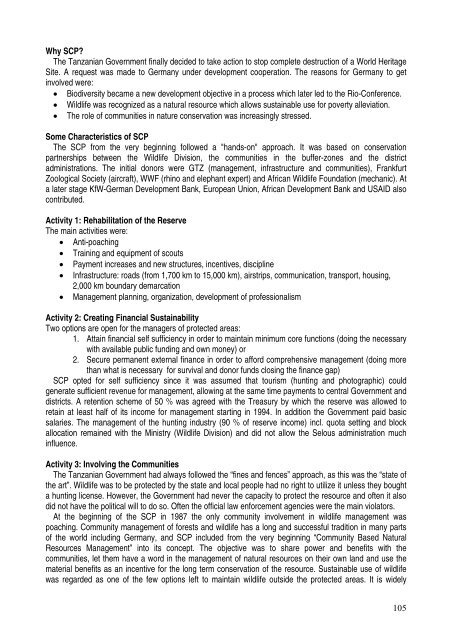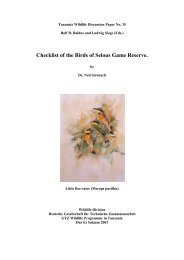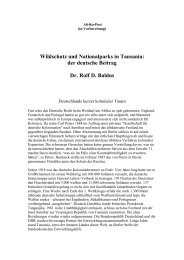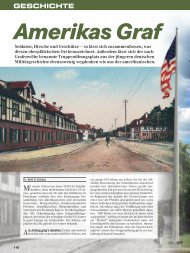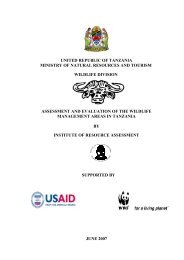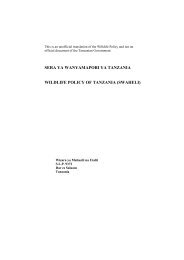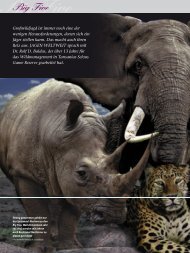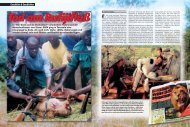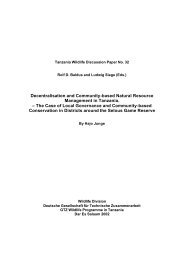African Indaba Articles - wildlife-baldus.com
African Indaba Articles - wildlife-baldus.com
African Indaba Articles - wildlife-baldus.com
Create successful ePaper yourself
Turn your PDF publications into a flip-book with our unique Google optimized e-Paper software.
Why SCP?The Tanzanian Government finally decided to take action to stop <strong>com</strong>plete destruction of a World HeritageSite. A request was made to Germany under development cooperation. The reasons for Germany to getinvolved were:• Biodiversity became a new development objective in a process which later led to the Rio-Conference.• Wildlife was recognized as a natural resource which allows sustainable use for poverty alleviation.• The role of <strong>com</strong>munities in nature conservation was increasingly stressed.Some Characteristics of SCPThe SCP from the very beginning followed a "hands-on" approach. It was based on conservationpartnerships between the Wildlife Division, the <strong>com</strong>munities in the buffer-zones and the districtadministrations. The initial donors were GTZ (management, infrastructure and <strong>com</strong>munities), FrankfurtZoological Society (aircraft), WWF (rhino and elephant expert) and <strong>African</strong> Wildlife Foundation (mechanic). Ata later stage KfW-German Development Bank, European Union, <strong>African</strong> Development Bank and USAID alsocontributed.Activity 1: Rehabilitation of the ReserveThe main activities were:• Anti-poaching• Training and equipment of scouts• Payment increases and new structures, incentives, discipline• Infrastructure: roads (from 1,700 km to 15,000 km), airstrips, <strong>com</strong>munication, transport, housing,2,000 km boundary demarcation• Management planning, organization, development of professionalismActivity 2: Creating Financial SustainabilityTwo options are open for the managers of protected areas:1. Attain financial self sufficiency in order to maintain minimum core functions (doing the necessarywith available public funding and own money) or2. Secure permanent external finance in order to afford <strong>com</strong>prehensive management (doing morethan what is necessary for survival and donor funds closing the finance gap)SCP opted for self sufficiency since it was assumed that tourism (hunting and photographic) couldgenerate sufficient revenue for management, allowing at the same time payments to central Government anddistricts. A retention scheme of 50 % was agreed with the Treasury by which the reserve was allowed toretain at least half of its in<strong>com</strong>e for management starting in 1994. In addition the Government paid basicsalaries. The management of the hunting industry (90 % of reserve in<strong>com</strong>e) incl. quota setting and blockallocation remained with the Ministry (Wildlife Division) and did not allow the Selous administration muchinfluence.Activity 3: Involving the CommunitiesThe Tanzanian Government had always followed the “fines and fences” approach, as this was the “state ofthe art”. Wildlife was to be protected by the state and local people had no right to utilize it unless they boughta hunting license. However, the Government had never the capacity to protect the resource and often it alsodid not have the political will to do so. Often the official law enforcement agencies were the main violators.At the beginning of the SCP in 1987 the only <strong>com</strong>munity involvement in <strong>wildlife</strong> management waspoaching. Community management of forests and <strong>wildlife</strong> has a long and successful tradition in many partsof the world including Germany, and SCP included from the very beginning “Community Based NaturalResources Management” into its concept. The objective was to share power and benefits with the<strong>com</strong>munities, let them have a word in the management of natural resources on their own land and use thematerial benefits as an incentive for the long term conservation of the resource. Sustainable use of <strong>wildlife</strong>was regarded as one of the few options left to maintain <strong>wildlife</strong> outside the protected areas. It is widely105


